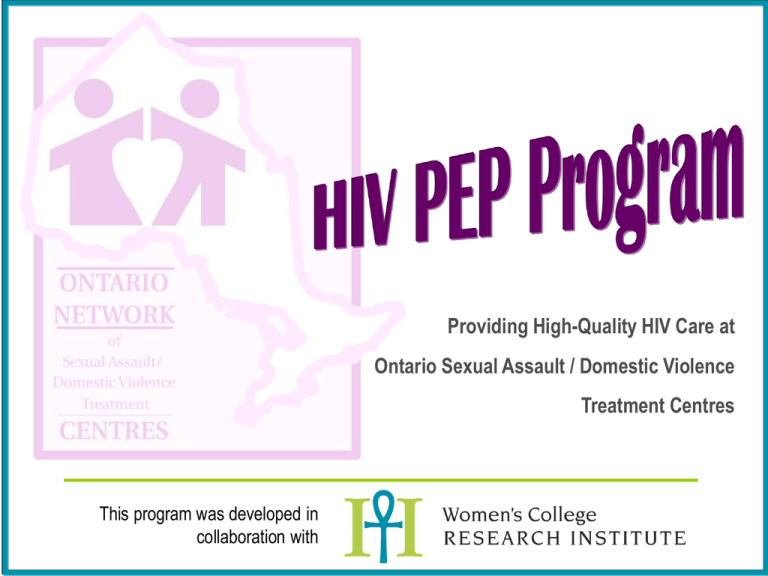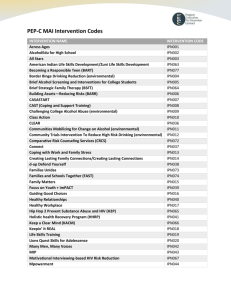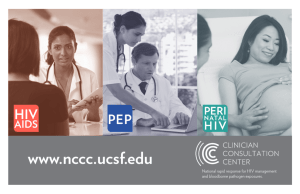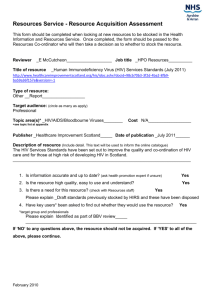
Providing High-Quality HIV Care at
Ontario Sexual Assault / Domestic Violence
Treatment Centres
This program was developed in
collaboration with
Outline
Rationale for HIV PEP program
Background on HIV
Introduction to the HIV PEP program
HIV PEP Regimen: Combivir® and Kaletra®
Assessing HIV risk
Follow-up HIV counselling
Importance of the HIV PEP program in your community
Accessing more HIV PEP program information
HIV
PEP
PROGRAM
Providing high-quality HIV care through the Ontario Network of Sexual Assault/Domestic Treatment Centres
HIV PEP Program
Rationale
Need for Response to HIV Risk
Post Sexual Assault
39% of Canadian women experience at least one incident of sexual assault since
the age of 16 1
Approximately 2,000 sexual assault victims/survivors present to Sexual
Assault/Domestic Violence Treatment Centres (SATC) in Ontario each year
Over 95% are women
Women are twice as likely as men to contract HIV during (vaginal) intercourse 2
HIV transmission following sexual assault may be greater (than consensual sex)
due to genital/rectal trauma and bleeding, exposure to multiple assailants,
exposure through multiple receptive sites, and/or presence of STIs (in the assailant
or victim)
1. Federal/Provincial/Territorial Ministers Responsible for the Status of Women. 2002. Assessing Violence Against Women: A Statistical Profile.
2. European Study Group. 1992. Comparison of female to male and male to female transmission of HIV in 563 stable couples. BMJ. 304: 809-13.
HIV
PEP
PROGRAM
Providing high-quality HIV care through the Ontario Network of Sexual Assault/Domestic Treatment Centres
HIV PEP in Other Exposures
HIV PEP is widely used in other settings1-3
Occupational exposure
Mother-to-child transmission
1. CDC. 2005. Antiretroviral Postexposure Prophylaxis After Sexual, Injection-Drug Use, or Other Non-occupational Exposure to HIV in the United
States: Recommendations from the U.S. Department of Health and Human Services. MMWR. 54(RR-2): 1-20.
2. Grulich AE. 2003. Epidemiologically targeted post-exposure prophylaxis against HIV: An under-utilized prevention technology. HIV Medicine. 4:
193-4.
3. European Project on Non-Occupational Post Exposure Prophylaxis. 2002. Management of non-occupational post exposure prophylaxis to HIV:
Sexual, injection drug user or other exposures.
HIV
PEP
PROGRAM
Providing high-quality HIV care through the Ontario Network of Sexual Assault/Domestic Treatment Centres
HIV PEP Recommended
Post Sexual Assault
HIV PEP is recommended to prevent transmission
of HIV following occupational and non-occupational
exposures such as:
Unprotected sexual activities
Injection drug use
1. CDC. 2005. Antiretroviral Postexposure Prophylaxis After Sexual, Injection-Drug Use, or Other Non-occupational Exposure to HIV in the United
States: Recommendations from the U.S. Department of Health and Human Services. MMWR. 54(RR-2): 1-20.
HIV
PEP
PROGRAM
Providing high-quality HIV care through the Ontario Network of Sexual Assault/Domestic Treatment Centres
HIV PEP in Other Jurisdictions
Guidelines for the provision of HIV PEP following sexual assault have been
developed and implemented in multiple North American and European jurisdictions
Europe 1 : Austria, Belgium, Denmark, France, Germany, Greece, Ireland, Italy,
Portugal, The Netherlands, United Kingdom, Slovenia, Spain, and Switzerland
Canada: British Columbia 2
United States: Rhode Island 3, New York 4, California 5, Massachusetts 6
1. European Project on Non-Occupational Post Exposure Prophylaxis. 2002. Management of non-occupational post exposure prophylaxis to HIV:
Sexual, injection drug user or other exposures
2. Wiebe ER, Comay SE, McGregor M, Ducceschi S. 2000. Offering HIV prophylaxis to people who have been sexually assaulted: 16 months'
experience in a sexual assault service. Canadian Medical Association Journal. 162(5): 641-5.
3. Non-occupational HIV PEP Task Force, Brown University AIDS Program, and the Rhode Island Department of Health. 2002. Non-occupational
human immunodeficiency virus post-exposure prophylaxis guidelines for Rhode Island healthcare practitioners.
4. New York State Department of Health AIDS Institute. 2004. HIV Prophylaxis Following Non-Occupational Exposure Including Sexual Assault.
5. Myles JE, Bamberger J. 2001. Offering HIV Prophylaxis Following Sexual Assault: Recommendations for the State of California. Prepared for
the Housing and Urban Health of the San Francisco Department of Public Health and The California HIV PEP after Sexual Assault Task
Force in conjunction with The California State Office of AIDS.
6. Massachusetts Department of Public Health. 2005. HIV Prophylaxis Following Non-Occupational Exposures Recommended Protocol
Components.
HIV
PEP
PROGRAM
Providing high-quality HIV care through the Ontario Network of Sexual Assault/Domestic Treatment Centres
Background on HIV
HIV Virology
Different types of HIV
HIV-1 & HIV-2 (concentrated in Western Africa)
Different clades of HIV-1 (A, B, C, D, E, F, G, K and O)
Clade B in North America
HIV is an RNA virus (2 strands of RNA)
HIV is a retrovirus
Replicative enzyme = reverse transciptase
Other important components
Envelope – gp160 = gp120 + gp41
Capsid – p24 antigen
Enzymes – protease & integrase
HIV
PEP
PROGRAM
Providing high-quality HIV care through the Ontario Network of Sexual Assault/Domestic Treatment Centres
HIV Virus Structure
HIV Replication
After initial infection immediate replication
10 X 109 new viral products produced each day
HIV binds to CD4 receptor on macrophages and
CD4 T lymphocytes via gp120
Co-receptor also needed – CXCR4 or CCR5
HIV
PEP
PROGRAM
Providing high-quality HIV care through the Ontario Network of Sexual Assault/Domestic Treatment Centres
HIV Life Cycle
HIV Transmission
A person infected with HIV carries the virus in body fluids, such as:
Blood
Semen or vaginal secretions
Breast milk
The virus is transmitted when HIV-infected fluids enter the bloodstream of another person
Transmission can occur through:
The mucus membrane linings of the vagina, rectum, mouth, or the opening at the tip of the penis
Intravenous injection with a syringe
Through a break in the skin, such as a cut or sore
HIV is typically transmitted through unprotected sexual intercourse (oral, vaginal or anal),
with someone who is HIV-infected, sharing needles/syringes with someone who is HIVinfected, or infection during pregnancy, childbirth, or breast-feeding (mother-to-infant
transmission)
HIV
PEP
PROGRAM
Providing high-quality HIV care through the Ontario Network of Sexual Assault/Domestic Treatment Centres
Increased Risk of HIV Transmission
Risk of HIV infection following exposure is dependent upon the
type of exposure itself, but also on a number of co-factors, such as:
Infectivity of the source (high plasma viral load increases risk)
Presence of ulcerations (open sores) on the genitals (sexual exposure)
Presence of sexually transmitted infections (STI) or bleeding (STIs increase
risk by 2-5x, WHO, 2004). (sexual exposure)
“HIV Risk Assessment” (Slides 33 – 36), outlines this continuum of
HIV risk and identifies the various factors that increase risk within
the context of sexual assault
HIV
PEP
PROGRAM
Providing high-quality HIV care through the Ontario Network of Sexual Assault/Domestic Treatment Centres
Preventing HIV Infection
Treatment for HIV infection: antiretrovirals
4 classes: Nucleoside Reverse Transcriptase Inhibitors (NRTI), Non-
Nucleoside Reverse Transcriptase Inhibitors (NNRTI), Protease Inhibitors
(PI), Fusion inhibitors
3 drugs from 2 classes typically used
HIV PEP – given to prevent HIV infection
28-day treatment of antiretroviral drugs taken twice a day
Recall the HIV life cycle
Through the reverse transcription – integration – transcription process, HIV
binds with cell DNA, the altered virus then releases to multiply
Fusion inhibitors block entry of the virus
NRTIs & NNRTIs block reverse transcription
PIs block assembly of the virus
HIV
PEP
PROGRAM
Providing high-quality HIV care through the Ontario Network of Sexual Assault/Domestic Treatment Centres
HIV in Canada
HIV is a growing issue in Canada
Total number of people in Canada living with HIV/AIDS infection estimated to
be 56,000 (2002)
Total estimated new infections (incidence) in 2002 between 2,800 and 5,200
95% of reported HIV and AIDS diagnoses in Canada are in the
provinces of Ontario, Quebec, British Columbia and Alberta
Over 85% of Canada’s population resides in these four provinces
Public Health Agency of Canada. May 2005. HIV/AIDS EPI Updates. Surveillance and Risk Assessment Division, Centre for Infectious Disease
Prevention and Control, Public Health Agency of Canada.
HIV
PEP
PROGRAM
Providing high-quality HIV care through the Ontario Network of Sexual Assault/Domestic Treatment Centres
Shifting Demographics
Patterns of HIV transmission are currently shifting
Although men who have sexual contact with men
(MSM) account for the largest proportion of positive
HIV test reports (43.5% in 2005)…
Heterosexual transmission is increasing (30.9% of HIVpositive test reports in Canada, 2005) 1
1. Public Health Agency of Canada. 2006. HIV and AIDS in Canada: Surveillance Report to December 31, 2005. Surveillance and Risk
Assessment Division, Centre for Infectious Disease Prevention and Control
HIV
PEP
PROGRAM
Providing high-quality HIV care through the Ontario Network of Sexual Assault/Domestic Treatment Centres
Introduction to the
HIV PEP Program
HIV PEP Program History
1999: Need for prophylaxis identified; Ontario Network of SATCs requested funding for HIV PEP
medications from the Ministry of Health and Long-Term Care (MOHLTC)
2002: MOHLTC funded the HIV PEP Study to determine feasibility of HIV PEP program
September 10, 2003 – January 31, 2005: Data were
collected on 1,103 consecutive sexual assault victims/survivors presenting to 24 participating SATCs
December 21, 2005: Recommendations for an ongoing HIV PEP program were
submitted to the MOHLTC; Findings indicated that a universal HIV PEP program:
Was well-received and appreciated by sexual assault victims/survivors
Enabled Health Care Providers to effectively support all clients at risk of HIV acquisition in their HIV PEP
decision-making
Improved the quality of sexual assault care in Ontario
HIV
PEP
PROGRAM
Providing high-quality HIV care through the Ontario Network of Sexual Assault/Domestic Treatment Centres
HIV PEP Program Today
February 2006: CIHR funded a 1-year Knowledge Exchange grant that is
developing Knowledge Transfer (KT) Tools to assist the Ontario Network of SATCs in
sustaining a standardised HIV PEP program and will support Ontario’s HCPs in providing
high-quality HIV care to Ontario’s sexual assault victims/survivors. KT Tools include:
Updated & revised HIV PEP program materials
Targeted information packages
Online information & education packages
Targeted education & outreach strategies
August 2006: MOHLTC committed
to providing ongoing base
funding to Ontario’s 34 SATCs to support the universal offering of HIV PEP medications
HIV
PEP
PROGRAM
Providing high-quality HIV care through the Ontario Network of Sexual Assault/Domestic Treatment Centres
HIV PEP Program Guidelines
All clients to receive counselling about potential HIV risks;
All clients at any risk of HIV infection (known or unknown) to be
offered HIV PEP;
HIV PEP to begin within 72-hours of exposure;
HIV PEP to be prescribed for a period of 28-days;
An intensive follow-up schedule to assist clients who choose the
prophylactic drugs to cope with side effects and complete the
medication course; and,
HIV PEP to be provided at no cost to clients.
HIV
PEP
PROGRAM
Providing high-quality HIV care through the Ontario Network of Sexual Assault/Domestic Treatment Centres
Drug Funding
Presently
HIV PEP medications dispensed by SATCs are
reimbursed monthly through claim submissions to the
Ontario Network of SATCs Provincial Coordinator,
Sheila Macdonald
Starting April 1, 2007
HIV PEP funding will flow through the LHINs
Each SATC will be allocated annual funds for
purchasing HIV PEP medications
HIV
PEP
PROGRAM
Providing high-quality HIV care through the Ontario Network of Sexual Assault/Domestic Treatment Centres
HIV PEP Regimen:
Combivir® & Kaletra®
Drug Regimen
Daily HIV PEP dose:
Combivir® (300 mg zidovudine & 150 mg lamivudine), 1 tablet orally BID
Kaletra® (200 mg lopinavir & 50 mg ritonavir), 2 tablets orally BID
The course of HIV PEP therapy is 28 days
Schedule for the provision of HIV PEP:
Initial Visit: 5-day "Starter Kit" (10 tablets of Combivir® + 20 tablets of Kaletra®)
1st Follow-up: 10-day Follow-up Kit (20 tablets of Combivir® + 40 tablets of Kaletra®)
3rd Follow-up: 7-day Follow-up Kit (14 tablets of Combivir® + 28 tablets of Kaletra®)
4th Follow-up: 6-day Follow-up Kit (12 tablets of Combivir® + 24 tablets of Kaletra®)
HIV
PEP
PROGRAM
Providing high-quality HIV care through the Ontario Network of Sexual Assault/Domestic Treatment Centres
Paediatric Drug Regimen
Children 12 years of age AND 50 kg.
Prescribe adult HIV PEP regimen (Combivir ® and Kaletra ®)
Children < 12 years of age AND < 50 kg.
Determine the drug dosage using the paediatric dosing charts:
Zidovudine & Lamivudine (components of Combivir ®)
Lopinavir & Ritonavir (components of Kaletra®)
See “Paediatric Dosing Charts”
Appendix 1C, Medical Guidelines
HIV
PEP
PROGRAM
Providing high-quality HIV care through the Ontario Network of Sexual Assault/Domestic Treatment Centres
About Combivir® & Kaletra®
Combivir®
Contains 2 Reverse Transcription Inhibitors in one pill
AZT & 3TC
Well tolerated – main side effect: headache, nausea, fatigue
Serious side effect: anemia from AZT
Kaletra®
Contains 1 Protease Inhibitor with ritonavir to boost the level of
the drug & maximise its efficacy
Well tolerated – main side effect: diarrhea
HIV
PEP
PROGRAM
Providing high-quality HIV care through the Ontario Network of Sexual Assault/Domestic Treatment Centres
Storage & Dispensing Info
Storage
Kaletra® - store in a cool (20°- 25°C) dry place, protected from light
Combivir® - store in a cool (15 - 30C) dry place
Bottle sizes:
Combivir® - 60 tablets per bottle (30 day supply)
Kaletra® - 120 tablets per bottle (30 day supply)
Food requirements:
Both Combivir® and Kaletra® can be taken with or without food
HIV
PEP
PROGRAM
Providing high-quality HIV care through the Ontario Network of Sexual Assault/Domestic Treatment Centres
Health Contraindications to HIV PEP
Combivir is contraindicated in clients who have:
Taken myelosuppressive or hemotoxic drugs within two weeks of
starting PEP drugs;
A history of bone marrow insufficiency or severe anemia; and/or
Acute pancreatitis
Kaletra is contraindicated in clients with:
Acute or advanced liver failure
HIV
PEP
PROGRAM
Providing high-quality HIV care through the Ontario Network of Sexual Assault/Domestic Treatment Centres
Drug Contraindications to HIV PEP
Combivir and Kaletra may potentially interact
with other medications, including:
Prescriptions
Over the counter medications
Herbals
Illicit drugs
(Full list of contraindicated drugs available)
HIV
PEP
PROGRAM
Providing high-quality HIV care through the Ontario Network of Sexual Assault/Domestic Treatment Centres
Pregnancy & HIV PEP
Antiretroviral drugs are potentially teratogenic in the first trimester of
pregnancy
HIV PEP is often avoided during this period
However, if a woman is at increased-risk of HIV transmission, the
risk of transmission to the fetus is very high during seroconversion
Giving antiretroviral drugs in this scenario outweighs the risk of teratogenesis
The decision to take HIV PEP during pregnancy should be made by
the client, in consultation with an HIV Expert
HIV
PEP
PROGRAM
Providing high-quality HIV care through the Ontario Network of Sexual Assault/Domestic Treatment Centres
Assessing HIV Risk
Time Since Exposure
HIV PEP must be initiated within in 72-hours of exposure
HIV replicates at an accelerated rate
IF the virus has been transmitted, initiating HIV PEP > 72 hours post-
exposure may not aid in halting replication of the virus
If > 72-hours since assault by a known HIV-positive assailant
Refer the client to an HIV expert immediately – anti HIV therapy may be
initiated as early treatment for acute HIV infection
For all other clients presenting > 72 hours post-exposure
An immediate HIV test and follow-up HIV testing at 4-6 weeks, 3 and 6
months post-assault is recommended
HIV
PEP
PROGRAM
Providing high-quality HIV care through the Ontario Network of Sexual Assault/Domestic Treatment Centres
HIV Risk Assessment (1)
1. Determine HIV PEP Eligibility
No Risk
▪ NO penetration (anal, vaginal or oral)
▪ NO contact with assailant body fluid (e.g., blood; ejaculate)
+
ANY
Assailant
▪ ORAL penetration (Suspected, partial, or completed )
▪ Contact with assailant body fluid (e.g., blood; ejaculate)
via mucous membrane, non-intact skin or bite
▪ Unknown exposure (e.g., drug-assisted)
HIV
PEP
HIV PEP
Offer HIV PEP
▪ ANAL penetration (Suspected, partial, or completed )
▪ VAGINAL penetration (Suspected, partial, or completed )
At Risk
DO NOT Offer
ANY
+
COMBIVIR® &
KALETRA® (BID)
Assailant
PROGRAM
Providing high-quality HIV care through the Ontario Network of Sexual Assault/Domestic Treatment Centres
Provide counselling and
education
HIV Risk Assessment (2a)
2. Weigh Client HIV Risks (case-by-case assessment)
Two sets of factors must be considered when assessing HIV risk:
a) Exposure Risk Factors ; b) Assailant Risk Factors
a) Exposure Risk Factors
* Anal penetration ( Suspected, partial, or completed )
* Vaginal penetration (Suspected, partial, or completed )
IF any of these factors were
* Anal, vaginal or oral injuries
present during the assault,
* Blood in the anus, vagina or mouth
HIV risk is
* Presence of sexually transmitted infections
INCREASED
* Presence of ulcerations (open sores) on the genitals
* Assault by multiple assailants
* Multiple receptive sites
* Oral penetration only ( NO vaginal OR anal penetration )
These factors may
* Contact with assailant body fluid only (e.g., blood; ejaculate)
DECREASE
via mucous membrane, non-intact skin or bite
* No ejaculation
HIV risk
1
* Condom use
1
NOTE: These factors are often difficult to assess in cases of sexual assault, as victims/survivors may not know if the assailant ejaculated or whether condoms
were used properly or at all. Therefore, caution should be used when considering them in the risk assessment. Unless no penetration occurs, these factors
only decrease the risk and do not make it zero.
HIV
PEP
PROGRAM
Providing high-quality HIV care through the Ontario Network of Sexual Assault/Domestic Treatment Centres
HIV Risk Assessment (2b)
2. Weigh Client HIV Risks (case-by-case assessment)
Two sets of factors must be considered when assessing HIV risk: a) Exposure Risk Factors;
b) Assailant Risk Factors
b) Assailant Risk Factors
* Assailant known to be HIV-positive
* Assailant known or suspected to have HIV risk factors
HIV Risk Factors: * Has Hepatitis C
* Intravenous drug user
* Man who has sex with men
* From a country with an HIV prevalence rate greater than 5%
(e.g., certain countries in Sub-Saharan Africa)
* Has numerous sexual partners
* Has a sexually transmitted infection
* Engages in prostitution or trades sex for money/drugs
* Has sex with known or suspected HIV-positive people
* Has prior convictions for sexual assault
* Has been in prison
HIV
PEP
IF any of these factors are
known or suspected,
HIV risk is INCREASED
PROGRAM
Providing high-quality HIV care through the Ontario Network of Sexual Assault/Domestic Treatment Centres
Per incident probabilities of HIV Transmission
RISK OF HIV TRANSMISSION
EXPOSURE TYPE
(HIV-positive source)
Non-Sexual Transmission
Blood Product
Needlesharing in IV drug use
Needlestick injury
1:1.1
1:149
1:300
(90%)
(0.67%)
(0.3%)
1:200
(0.5%)
Sexual Transmission (unprotected)
Receptive anal intercourse
(Penetration by a penis)
Insertive anal intercourse
(Penetrating with the penis)
Receptive vaginal intercourse
(Penetration by a penis)
Insertive vaginal intercourse
(Penetrating with the penis)
Receptive oral sex
(Penetration by a penis)
Insertive oral sex
(Penetrating with the penis)
1:1,538
(0.065%)
1:1,000
(0.10%)
1:2,000
(0.05%)
1:10,000
(0.01%)*
1:20,000
(0.005%)*
* Rates of oral sex refer only to oral penetration by penis (not oral/vaginal contact, which is a negligible risk unless blood is present)
Source: Centres for Disease Control, January 2005
HIV
PEP
PROGRAM
Providing high-quality HIV care through the Ontario Network of Sexual Assault/Domestic Treatment Centres
Number & Prevalence of HIV-positive
residents 18 years and older in Ontario, 2006
FEMALES
MALES
Region
Northern
HIV
Number
Population
777,450
0.107%
0.539%
0.113%
1.060%
0.084%
0.131%
0.145%
6,127,586
0.337%
430
402,425
Ottawa
2,200
407,879
Eastern
460
405,709
Toronto
13,500
1,273,971
Central East
1,420
1,691,460
Central West
1,530
1,168,692
Southwest
1,130
20,670
Total Ontario
HIV
Prevalence
HIV
Number
Population
HIV
Prevalence
190
407,834
570
421,709
110
413,155
1,780
1,339,508
310
1,712,104
320
1,192,830
300
792,621
0.047%
0.135%
0.027%
0.133%
0.018%
0.027%
0.038%
3,580
6,279,761
0.057%
Source: Robert Remis, Ontario HIV Epidemiologic Monitoring Unit, Department of Public Health Sciences, University of Toronto, 2006.
2004 population estimates provided by Health Data and Decision Support Unit (HDDSU), Knowledge Management Branch, Ontario Ministry of Health and Long-Term Care
HIV
PEP
PROGRAM
Providing high-quality HIV care through the Ontario Network of Sexual Assault/Domestic Treatment Centres
For Example
Assessing HIV Risk
The Scenario
A 19-year-old woman arrives with a uniformed police officer at the emergency
department at 1:00pm
She has been sexually assaulted by an unknown man earlier that day (at
approximately 6:00am)
She discloses that she was orally and vaginally penetrated and that during the oral
assault, no condom was used and no ejaculation occurred. She is unsure if a
condom was used or if the assailant ejaculated during the vaginal assault
Multiple bruising is present on her inner thighs
HIV
PEP
PROGRAM
Providing high-quality HIV care through the Ontario Network of Sexual Assault/Domestic Treatment Centres
For Example
Assessing HIV Risk
Time since exposure: 7 hours
Less than 72 hours – continue HIV risk assessment
HIV PEP eligibility: oral penetration + vaginal penetration
At-Risk – eligible to be offered HIV PEP
Case-by-case assessment: Assailant risk factors – unknown;
Exposure risk factors – multiple receptive sites
HIV risk is increased – weigh risks / benefits with client
HIV
PEP
PROGRAM
Providing high-quality HIV care through the Ontario Network of Sexual Assault/Domestic Treatment Centres
For Example
Assessing HIV Risk
Considerations
Does the client currently take any medications (including
OTC, herbals, and/or illicit/street drugs)?
Does the client use the birth control pill?
Could the client be pregnant?
Does the client have any existing concerns regarding
sexually transmitted infections and/or HIV?
HIV
PEP
PROGRAM
Providing high-quality HIV care through the Ontario Network of Sexual Assault/Domestic Treatment Centres
Consulting with an HIV Expert
HIV Experts are available for consultation during business
hours, when needed
Local HIV Expert contact info is available via your SATC Coordinator
When to consult with an HIV Expert
Assailant known to be HIV-positive
Contraindications to HIV PEP exist (health and/or drug contraindications)
Client is pregnant
Client is a child under the age of 12 years
Client’s baseline HIV test returns positive
The client currently taking HIV PEP and having adherence difficulty
HIV
PEP
PROGRAM
Providing high-quality HIV care through the Ontario Network of Sexual Assault/Domestic Treatment Centres
Follow-up HIV
Counselling
Follow-up Care for Clients
Specific Issues
In addition to general emotional support:
Managing HIV PEP side effects
Majority of the side effects to Combivir® and Kaletra ® are not serious
Most common include headache, nausea/vomiting, stomach pain, diarrhea and/or fatigue
Usually manageable with common over-the-counter remedies, if required (e.g. calcium like TUMS
for diarrhoea)
Usually go away after 1-2 weeks
Contraception
Kaletra can decrease the effectiveness of long-term use birth control pills, so a barrier form of
contraceptive (e.g., condom) should be used
Pregnancy
Use of Combivir and Kaletra during pregnancy has not been extensively studied
Antiretroviral drugs are often avoided in the first trimester due to general concerns of
teratogenesis, so precautions to avoid pregnancy should be taken
HIV Testing
Recommended at 4-6 weeks, 3 and 6 months post-assault
HIV
PEP
PROGRAM
Providing high-quality HIV care through the Ontario Network of Sexual Assault/Domestic Treatment Centres
Importance of the
HIV PEP Program in
Your Community
Addressing HIV Concerns
Fear of HIV infection is common among sexual assault
victims/survivors, post-assault
The HIV PEP program offers counselling and medications
that can concretely address these fears
Experienced staff help to support HIV PEP decision-making
and to support sexual assault victims/survivors throughout
their course of HIV PEP therapy
HIV
PEP
PROGRAM
Providing high-quality HIV care through the Ontario Network of Sexual Assault/Domestic Treatment Centres
Providing High-Quality Care
HIV PEP medications are available at no cost to sexual assault
victims/survivors
Flexibility of the HIV PEP program allows diverse sexual assault
victim/survivor needs to be met
Services are tailored on a case-by-case basis
Increased follow-up services enhance support to clients taking HIV PEP
HIV counselling engages clinician-client discussion
Guidelines enable standardisation of HIV care across the province
HIV
PEP
PROGRAM
Providing high-quality HIV care through the Ontario Network of Sexual Assault/Domestic Treatment Centres
Your Role in HIV PEP Care
You are key in making information on the HIV PEP
program available those accessing your service
You can help sexual assault victims/survivors
address their HIV concerns by providing them with
information on:
The HIV PEP program
The local Sexual Assault/Domestic Violence Treatment
Centre (See list of SATC locations & information)
HIV
PEP
PROGRAM
Providing high-quality HIV care through the Ontario Network of Sexual Assault/Domestic Treatment Centres
Accessing More
HIV PEP Program
Information
How can I get more info?
More information on the HIV PEP program is available at
Contact Sheila Macdonald, Provincial Coordinator of the
Ontario Network of Sexual Assault/Domestic Violence
Treatment Centres
www.womensresearch.ca/programs/HIVPEP.php
sheila.macdonald@wchospital.ca
416.323.6400 ext. 4472
Pamphlets about the HIV PEP program are available for
your clients! Contact Sheila Macdonald.
HIV
PEP
PROGRAM
Providing high-quality HIV care through the Ontario Network of Sexual Assault/Domestic Treatment Centres
This material is adapted from documentation developed for the Ontario HIV PEP Study (2003-2005), funded by
the Ontario Women’s Health Council. Revision of HIV PEP program materials has been funded by a Knowledge
Transfer grant from the Canadian Institutes of Health Research. The Ontario Network of Sexual Assault/Domestic
Violence Treatment Centres acknowledges the contributions of the Women’s College Research Institute, the KTA
project Advisory Committee, and each regional SATC that assisted in the refining HIV PEP program materials.
HIV
PEP
PROGRAM
Providing high-quality HIV care through the Ontario Network of Sexual Assault/Domestic Treatment Centres




